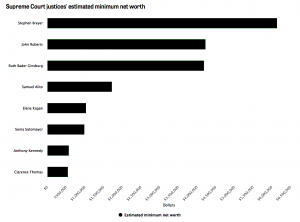No Better Time for Reform, Starting at the Top of the Court
Most Americans view the Constitution as a legal anchor, the fundamental protection of our basic rights and freedoms as citizens. Through the Judicial Branch — and by extension, through the decisions on cases over which it presides — States receive legal guidance that shape its course for policy and action. This Branch is the single, highest level of legal direction to uphold the laws of our country, and many of this country’s most challenging issues lay in the hands of a select few legal scholars of this powerful group. As Supreme Court decisions influence the direction of both federal and state policies, the Supreme Court is an unintended policy maker for our government.
Our textbook highlights one democratic perspective of the Judicial Branch and how it threatens our Democracy. It further explores the inherent risk when one of the three main branches of government consists of a small group of interpreters, particularly when these interpreters have never faced the judgment of voters, and have been selected for a lifetime tenure. Under this construct, we must ask the obvious question: Can the Judicial Branch effectively and impartially act in the best interests of the American people?
The pendulum of Judicial criticism has swung back and forth between parties within the last century. In the 1960s, a more liberal Supreme Court, consisting of famous justices like Thurgood Marshall and William J. Brennan, expanded American civil rights by supporting abortion, opposing the death penalty, and providing new protections for freedom of the press. In recent history, a more conservative Supreme Court has emerged – one that’s knocking out Obamacare and the Voting Rights Act. The exchange of criticism between both parties reveals the controversial nature of the appointment process and how ideological views can influence the Judicial Branch and its rulings.
In addition to ideological shifts, the Supreme Court is criticized for its elitist representation. The Court has evolved from what used to be a completely white, male-dominated counsel, to a more mixed representation of gender and racial minorities. However, Justices are still picked amongst the highest levels of American professions, repeatedly consisting of highly educated and wealthy individuals, feeding the Branch’s reputation of being the “aristocratic branch” of the Constitution. A second question emerges: Can a democracy that assigns an elite group to work out the meaning of liberty and equality be trusted?

Erwin Chemerinsky, a prominent constitutional lawyer, published a book called The Case Against the Supreme Court, which poses possible solutions to the democratic threats of the Judicial Branch. The first solution Chemerinsky mentions is opening the Supreme Court to cameras so as to expose the justices as a high-level committee of elite lawyers. This opens the discussion of exactly which decisions we want justices to decide – particularly when the issues concern protections of minority rights and liberties in the U.S. The second solution Chemerinsky lays out is to replace the lifetime term for a Supreme Court justice with an eighteen-year term. According to Chemerinsky, such limitations would allow for a new seat to open up every two years, and enable every president to receive an equal number of appointments. This makes appointment less arbitrary, which has been an issue in the past. For example, President Nixon was able to appoint four justices in just his first two years in office, while President Carter didn’t receive any appointment opportunities.
Implementing reforms on the Supreme Court will spark the beginning of a more balanced relationship between judgment and politics. Chemerrinsky’s reform ideas have come of age. We live in a new era of bi-partisan paralysis in Congress, and the risk of a politically-motivated Supreme Court is not an unlikely possibility, however unsettling it may be. Reforms to our highest court in the land are a step toward building a democracy that respects itself and reflects the wishes of ALL the people.
Graph: https://www.publicintegrity.org/2016/06/22/19804/majority-us-supreme-court-justices-are-millionaires
Other Sources:
https://onlinelibrary.wiley.com/doi/pdf/10.1111/j.1467-6478.2015.00720.x
https://www.thedailybeast.com/god-save-the-united-states-from-this-anti-democratic-court